15.01.2022
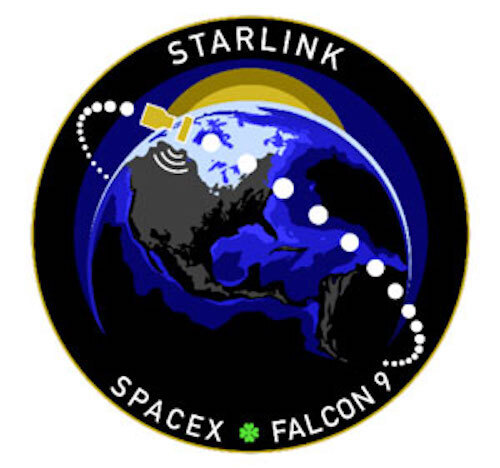
Despite the once-a-week cadence – at least so far this year – SpaceX has no intentions of slowing down. The company is again preparing for another Falcon 9 launch, this time at Kennedy Space Center's pad 39A. Liftoff of the 35th batch of Starlink internet satellites is currently targeted for a window between 7 p.m. and 8 p.m. ET Monday, Jan. 17.
It will mark the third polar, or southern trajectory, launch in a row for the Space Coast, a launch site previously seen as unfit to host those missions due to the additional expenditure of fuel and performance required to curve around South Florida. California's Vandenberg Space Force Base has historically been the host of most polar launches.
A weather forecast for that mission is expected no earlier than Friday.
Launch Monday, Jan. 17
- Rocket: SpaceX Falcon 9
- Mission: 35th batch of Starlink internet satellites
- Launch Time: Between 7 p.m. and 8 p.m. ET
- Launch Pad: 39A at Kennedy Space Center
- Trajectory: South
- Landing: Drone ship
- Weather: Forecast expected Friday
Quelle: Florida Today
----
Update: 17.01.2022
.
Cape Canaveral’s busy January to continue with another Starlink launch
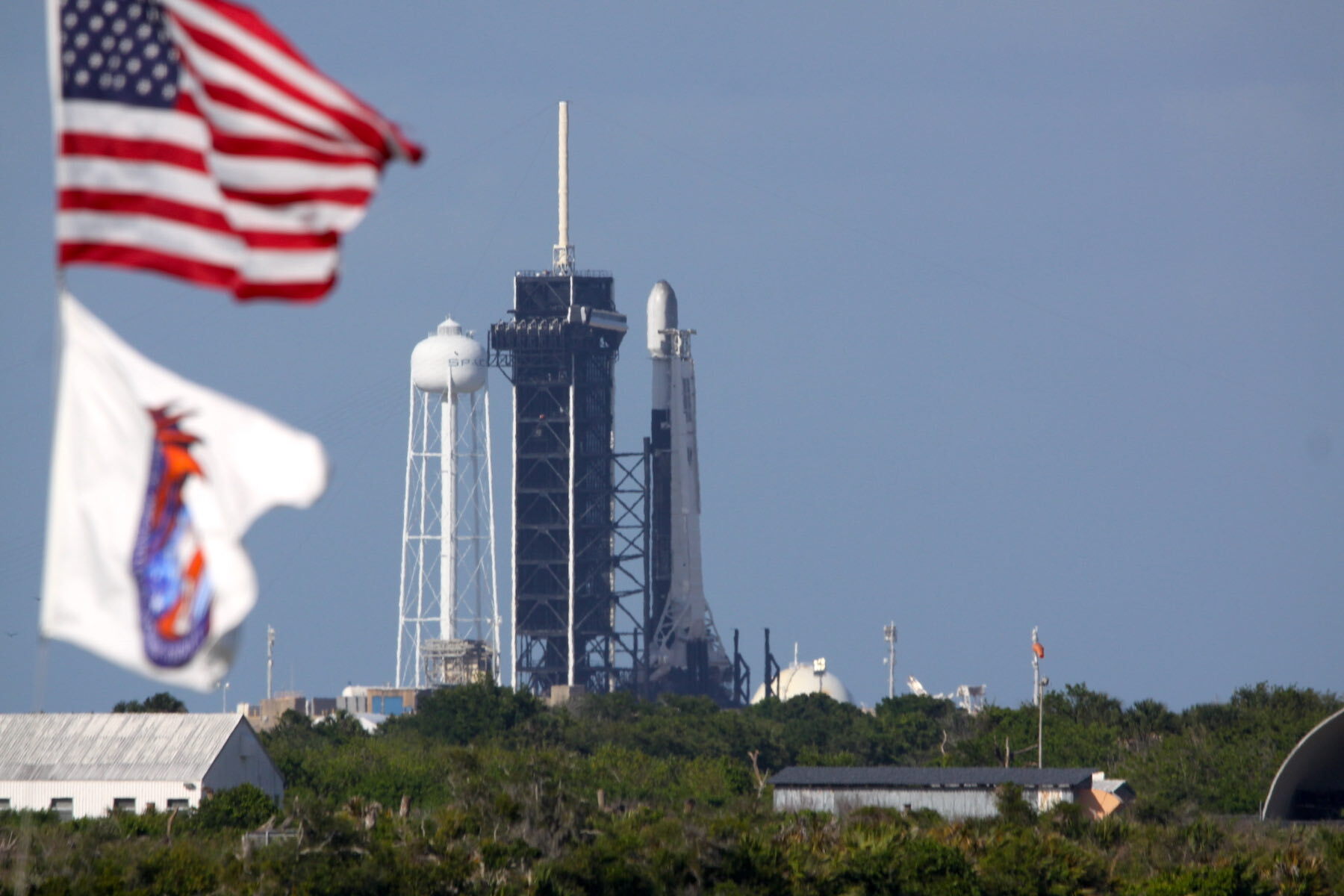
Forecasters expect brisk winds and chilly temperatures for a prime time, full moon launch of a SpaceX Falcon 9 rocket with another batch of Starlink internet satellites Monday night from NASA’s Kennedy Space Center in Florida.
There’s a 70 percent chance of good conditions for launch at 7:26 p.m. EST Monday (0026 GMT), according to a forecast issued Saturday morning by the U.S. Space Force’s 45th Weather Squadron. There’s a backup instantaneous launch opportunity at 9:24 p.m. EST (0224 GMT).
The mission, designated Starlink 4-6, will carry around 49 Starlink internet satellites into orbit for SpaceX’s global internet network. The Falcon 9 is expected to fly southeast from pad 39A at Kennedy Space Center, heading over the Atlantic Ocean just north of the Bahamas before making a slight right-hand turn to line up with the target orbital plane for deployment of the Starlink payloads.
The flight profile is expected to match that of the most recent Starlink launch Jan. 6, which was the first Starlink mission from Florida to head southeast, rather than northeast. That mission carried 49 flat-panel Starlink satellites into space. SpaceX hasn’t announced yet how many Starlink satellites are on Monday’s launch, but it’s expected to be a similar number.
Launch trajectories from Cape Canaveral have historically tracked east or northeast over the Atlantic Ocean.
But SpaceX, with approval from the Space Force’s Eastern Range, has opened new launch trajectories in recent years. Falcon 9 missions have also flown south along the Florida coastline to reach polar orbit, a destination that was inaccessible from Cape Canaveral for 50 years.
U.S. launches into polar orbit have typically departed from Vandenberg Space Force Base in California, which has an open range of ocean to the south of the spaceport.
The south and southeast launch paths from Cape Canaveral require rockets to perform turns, or “dog-leg” maneuvers, using some of their performance to fly around land masses and populated areas. That reduces the number of Starlink satellites SpaceX can launch on a single mission, but the company has said it intends to use the southeast launch trajectories in winter months to improve the chances of good offshore conditions for landing of the Falcon 9’s first stage booster.
For this mission, like the last Starlink launch, SpaceX’s drone ship will be parked north of the Abacos Islands in the Bahamas. For launches to the northeast, the landing platform is positioned east of Charleston, South Carolina, a region that sees rougher seas and higher winds in the winter.
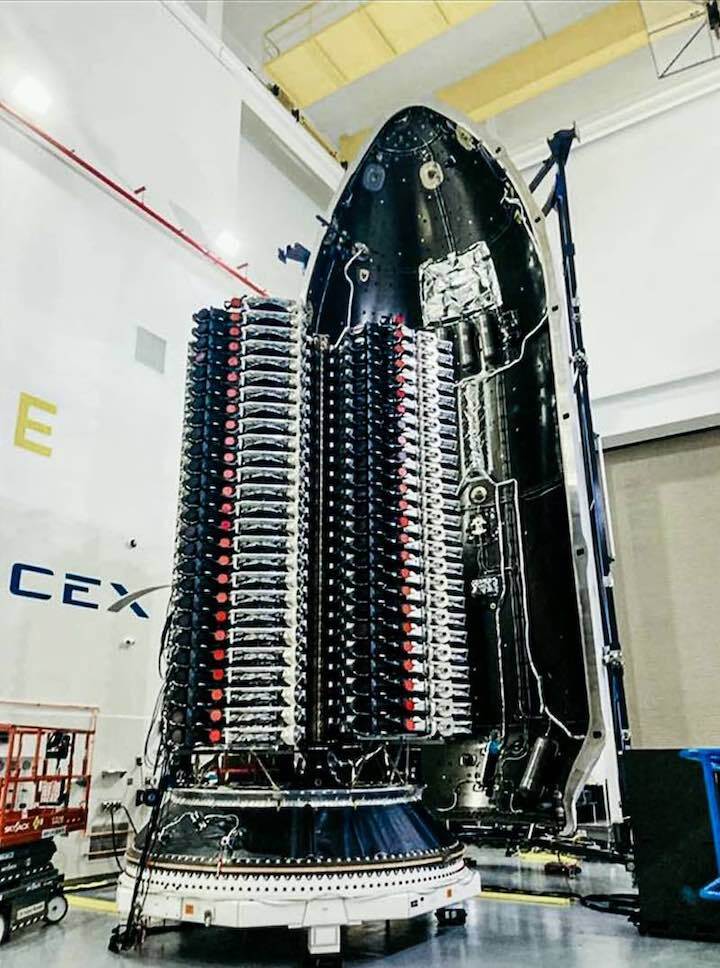
SpaceX will surpass the 2,000-satellite mark in its Starlink program with Monday night’s launch. Roughly 200 of those satellites have failed or been decommissioned by SpaceX’s ground control team, according to a tabulation maintained by Jonathan McDowell, an astrophysicist and respected tracker of global spaceflight activity.
The Starlink 4-6 mission will be SpaceX’s 35th dedicated launch since May 2019 for the Starlink program.
SpaceX has a long-term plan to launch as many as 42,000 Starlink satellites, according to a company filing with the International Telecommunication Union. The company’s initial focus is on deploying thousands of satellites into five orbital “shells.”
The 53.2-degree inclination shell, the target for Monday night’s launch is one of the five orbital shells at different inclination angles that SpaceX plans to fill with around 4,400 satellites to provide high-speed, low-latency broadband connectivity around the world. The first shell, at 53.0 degrees, was filled with its full complement of satellites last May.
As of last week, SpaceX said the Starlink network is now live in 25 countries and regions, serving more than 145,000 users worldwide. SpaceX builds its Starlink satellites on an assembly line in Redmond, Washington, and the company is developing and iterating its own user terminals.
SpaceX hopes to use revenue from the Starlink business unit to help fund the company’s ambitions to complete development of the heavy-lift Starship rocket, a massive fully reusable launcher designed to eventually replace the Falcon 9 and Falcon Heavy rockets.
On Monday night’s mission, the Falcon 9 rocket is expected to target an orbit a couple hundred miles above Earth. After flying free of the launch vehicle, the 49 Starlink satellites — each about a quarter-ton in mass — will unfurl solar panels and use ion thrusters to climb to an operational altitude of 335 miles (540 kilometers).
The forecast for Monday night calls for a mostly clear sky and gusty west winds of 20 to 25 mph. The temperature at launch times is forecast to be around 52 degrees Fahrenheit.
Rainy weather is expected along the Space Coast Sunday, but the weather system will push through the region in time for Monday evening’s launch opportunity, according to the Space Force weather team.
“Clouds will diminish through the day Monday at the spaceport, leaving gusty winds as the primary launch weather threat,” the forecaster team wrote. “On Tuesday, high pressure will settle overhead making for a chilly morning, but excellent launch weather conditions.”
The launch will continue a busy January at the Florida spaceport, with seven rocket launches scheduled on the Eastern Range. Two of the missions, both by SpaceX, are already in the books, with five more on tap before the end of the month, including Monday’s Falcon 9 flight.
A small satellite launcher developed by Astra is slated to take off as soon as next week from the Complex 46 launch pad at Cape Canaveral, carrying several CubeSats into orbit on a demonstration flight for NASA.
United Launch Alliance’s first mission of 2022 is scheduled for Friday, Jan. 21, with a pair of Space Force surveillance satellites heading to geostationary orbit.
Two more SpaceX launches are scheduled for the last week of January from each of the company’s Florida launch pads.
Quelle: SN
+++
Space Force: Weather mostly OK for SpaceX Starlink launch from Florida
Weather should be mostly favorable for the launch of a SpaceX Falcon 9 rocket from Kennedy Space Center on Monday, Space Force forecasters said, though conditions downrange in the Atlantic Ocean could be problematic.
When it comes to the area around pad 39A for the 7:26 p.m. liftoff time with Starlink internet satellites, conditions should be 70% "go" with low-level winds cited as the main concern. But not factored into the "percent go" are "moderate risk" chances for strong upper-level winds after liftoff and at-sea conditions that could disrupt SpaceX's chances at recovering the booster on a drone ship.
"Clouds will diminish through the day Monday at the spaceport, leaving gusty winds as the primary launch weather threat," Space Launch Delta 45 forecasters said Sunday.
Teams will have a two-hour window to fly. In the event of a delay to a similar timeframe Tuesday, conditions improve to greater than 90% "go."
"On Tuesday, high pressure will settle overhead making for a chilly morning, but excellent launch weather conditions," forecasters said.
If successful, SpaceX will have completed its 35th launch to date for Starlink, a space-based internet service provider quickly approaching 2,000 satellites in size. SpaceX eventually hopes to have tens of thousands flying in low-Earth orbit, which will have to constantly be replaced as hardware is upgraded and the upper atmosphere drags on the satellites, slowly pulling them down.
Monday's launch marks the third in as many weeks into the new year. Four more are tentatively scheduled through the end of the month, though keeping up with that rapid of a cadence will require sticking to a tight schedule – a task historically interrupted by weather, technical issues, or a mix of both.
Spectators should note that this mission includes a southern trajectory, so Falcon 9 will not launch from pad 39A and fly along its more common northeastern flightpath.
Launch Monday, Jan. 17
- Rocket: SpaceX Falcon 9
- Mission: 35th batch of Starlink internet satellites
- Launch Time: 7:26 p.m. ET
- Launch Window: Two hours
- Launch Pad: 39A at Kennedy Space Center
- Trajectory: South
- Landing: Drone ship
- Weather: 70% "go"
Quelle: Florida Today
----
Update: 18.01.2022
.
Weather forces SpaceX to delay Starlink launch from Kennedy Space Center
Forecasted weather conditions for the launch of a Falcon 9 rocket from Kennedy Space Center forced SpaceX teams to delay the liftoff by 24 hours to Tuesday evening.
"With more favorable weather conditions for liftoff and booster recovery, now targeting Tuesday, January 18, at 7:04 p.m. ET for Falcon 9’s launch of Starlink satellites," SpaceX said Monday.
Conditions for a Monday attempt, which would have flown at 7:26 p.m., were calculated by the Space Force at 70% "go." Weather for Tuesday's launch from pad 39A, however, improve significantly to greater than 90% "go" thanks to high pressure settling overhead. Cool weather will remain in the area, too.
"On Tuesday, high pressure will settle overhead, making for another chilly morning with low temperatures near 45 degrees at the spaceport," Space Launch Delta 45 forecasters said Monday. "Skies will continue to be mostly cloud-free and with winds becoming light and variable, making excellent weather conditions for a Tuesday evening launch attempt."
Forecasters also said all three additional variables not calculated into the "percent go" – upper-level winds, drone ship recovery weather, and solar flare activity – were all described as "low risk." Monday's attempt had been "moderate risk."
Packed into this Falcon 9's payload fairing will be 49 Starlink satellites that mark the company's 35th dedicated launch for the internet constellation. SpaceX eventually hopes to operate tens of thousands in low-Earth orbit.
Spectators should note that Tuesday's launch will fly a southern trajectory, a typically rare mission for the Space Coast due to the additional energy needed to fly around the southern tip of Florida. All of January's missions so far, however, have flown toward the south.
Quelle: Florida Today
----
Update: 19.01.2022
.
Start von SpaceX’s 34th Starlink v1.0 mission and 35th Starlink launch
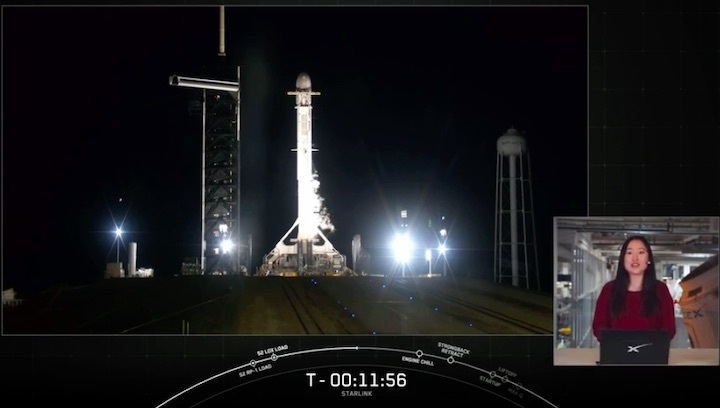
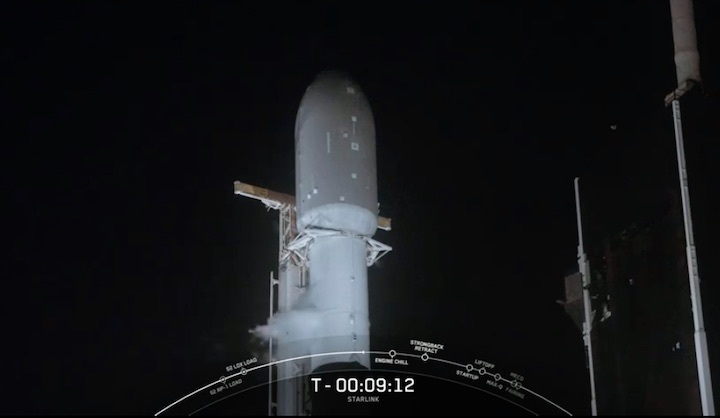
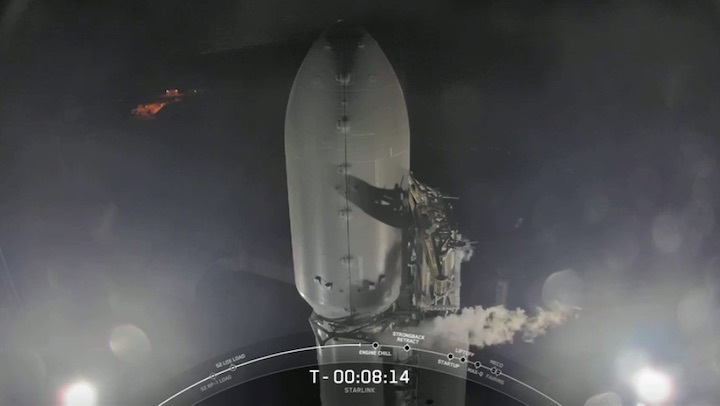
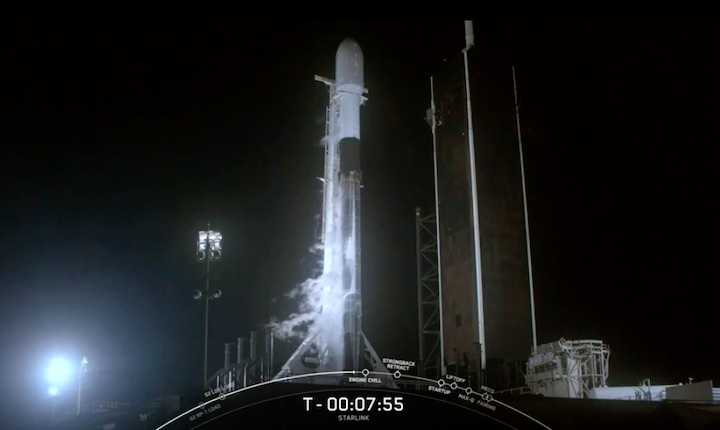
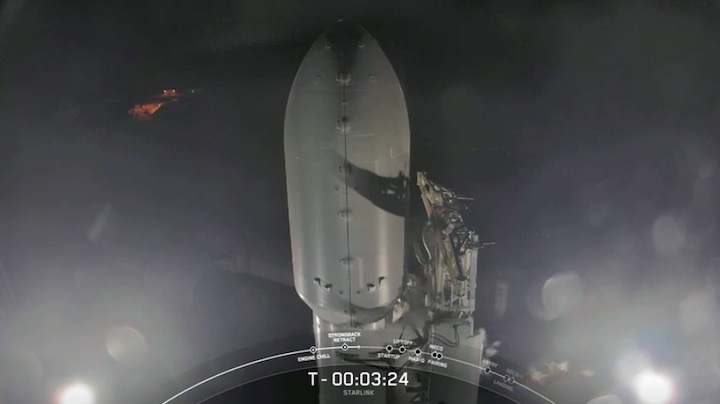
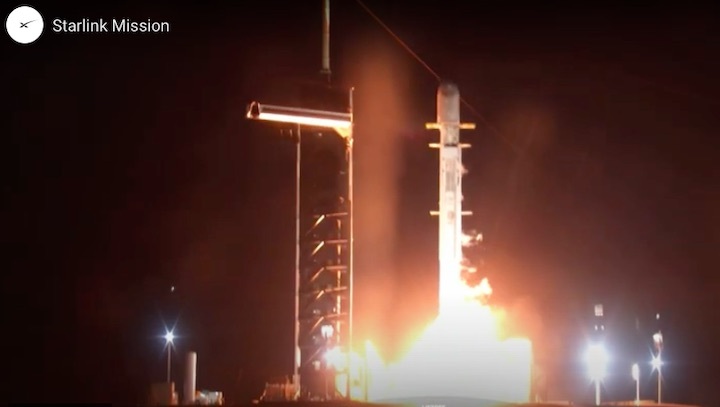
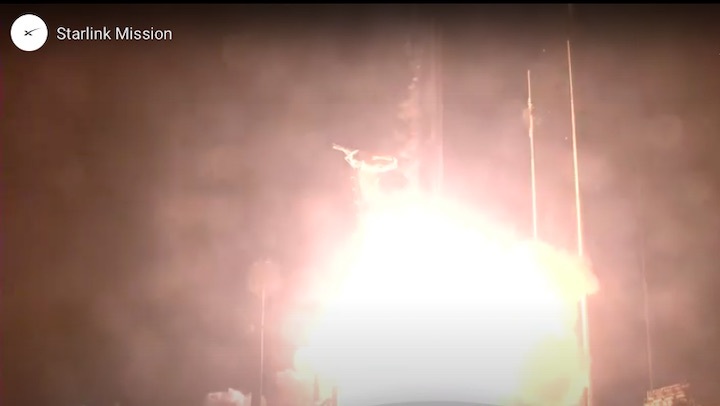
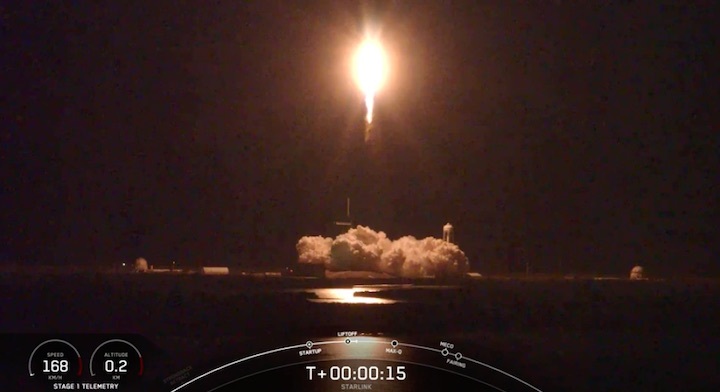
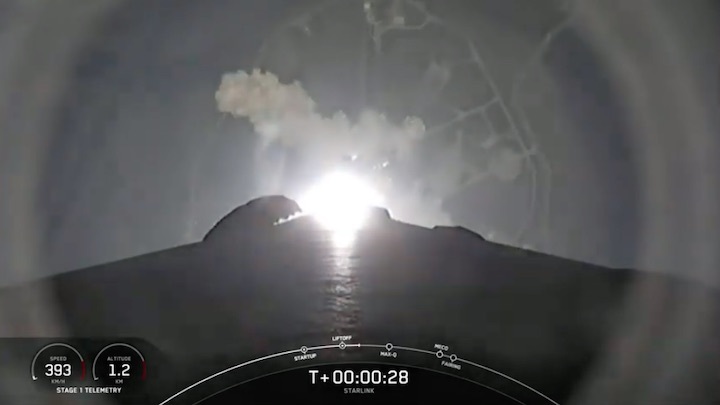
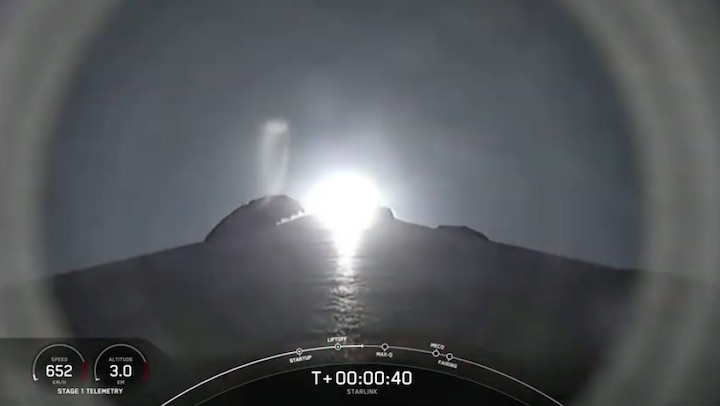
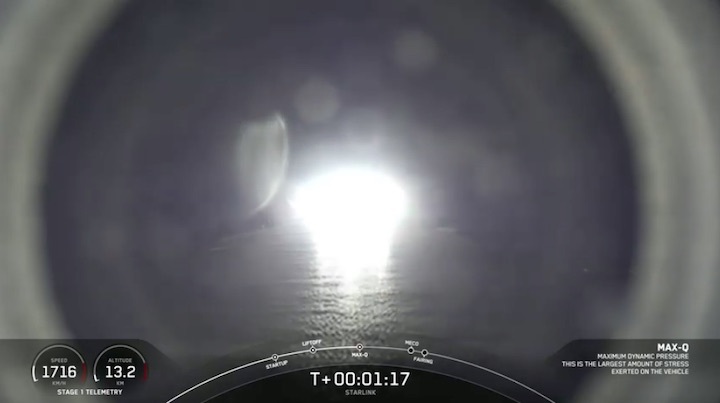
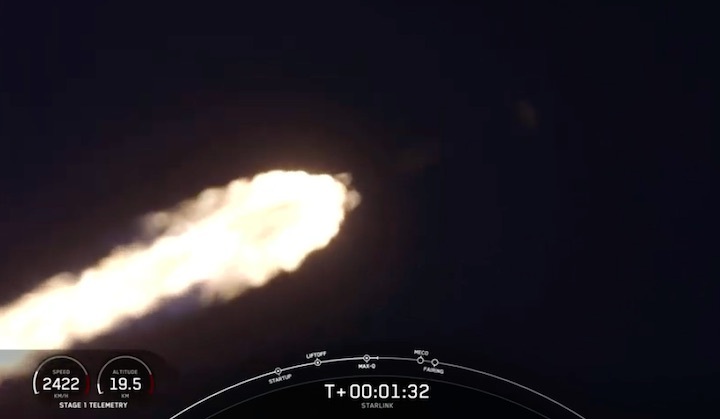
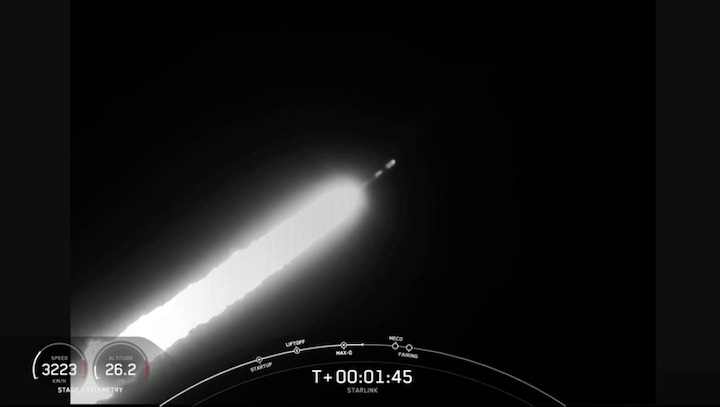
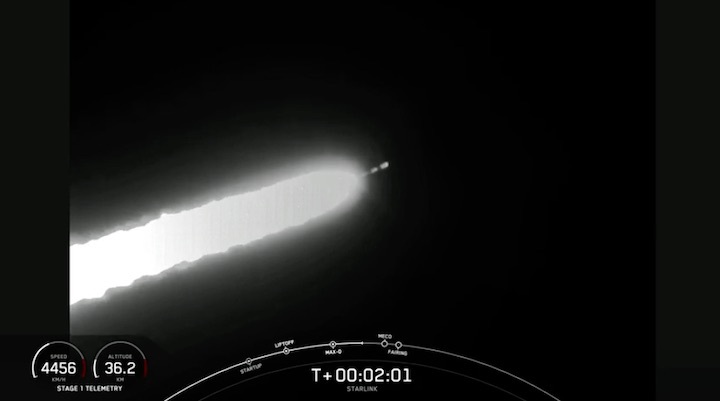
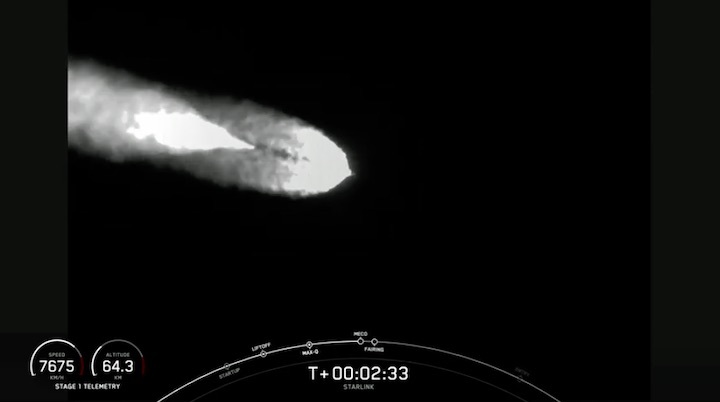
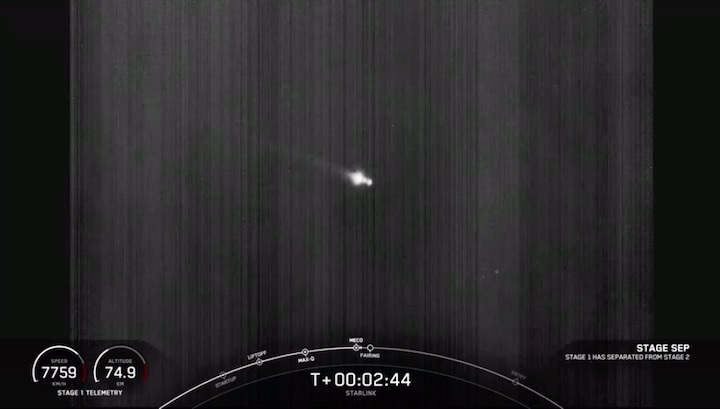
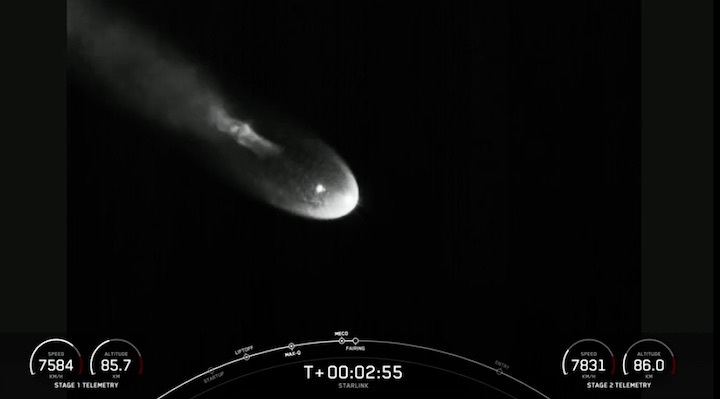
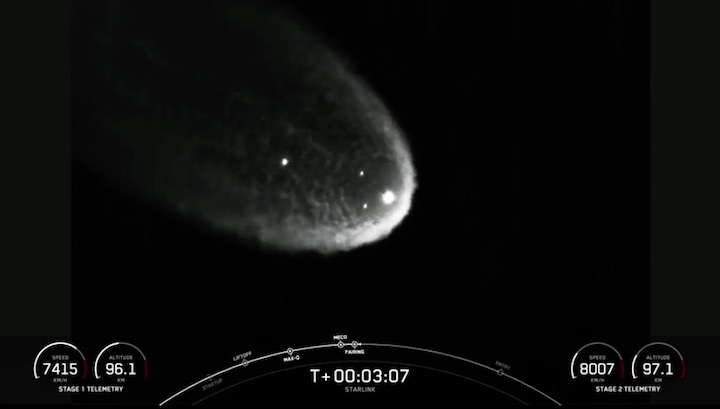
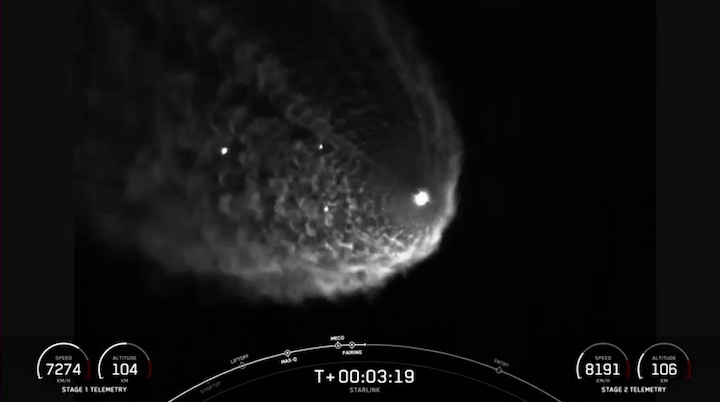
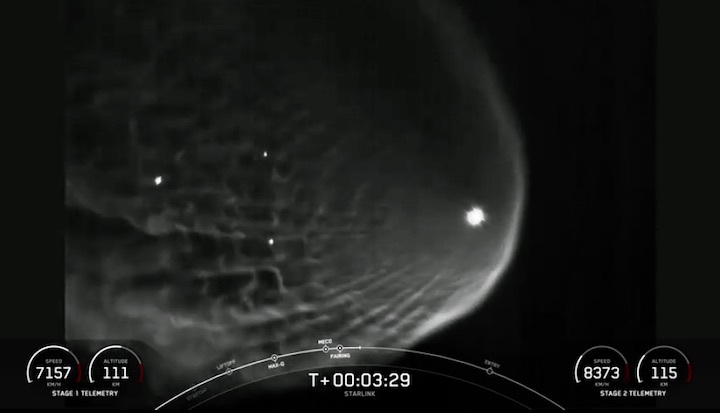
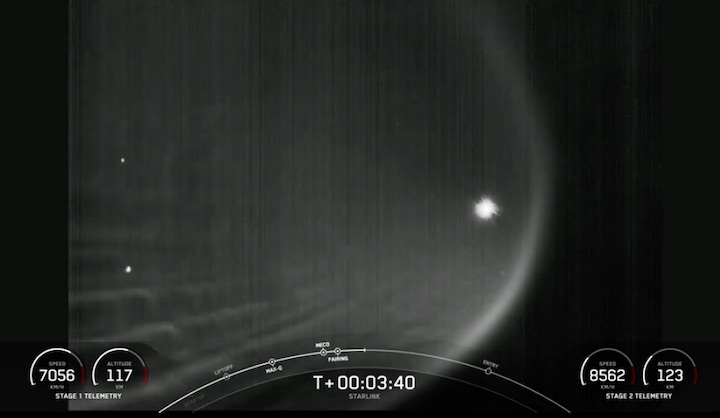
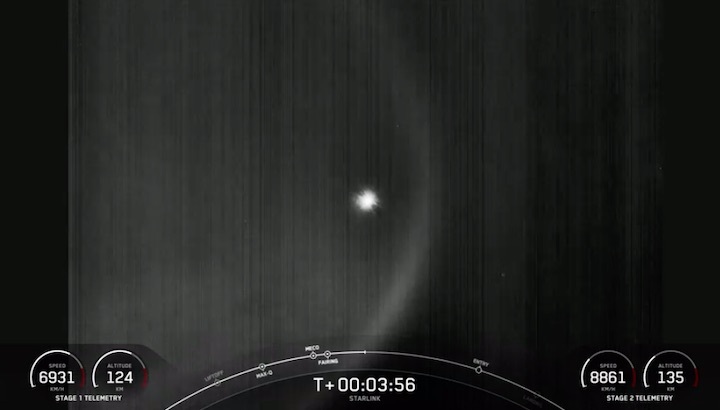
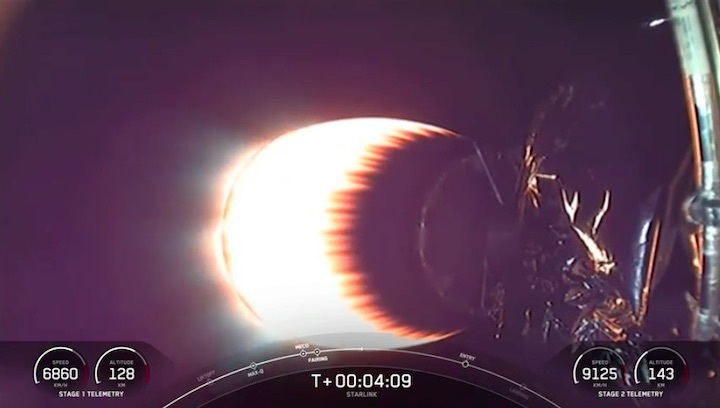
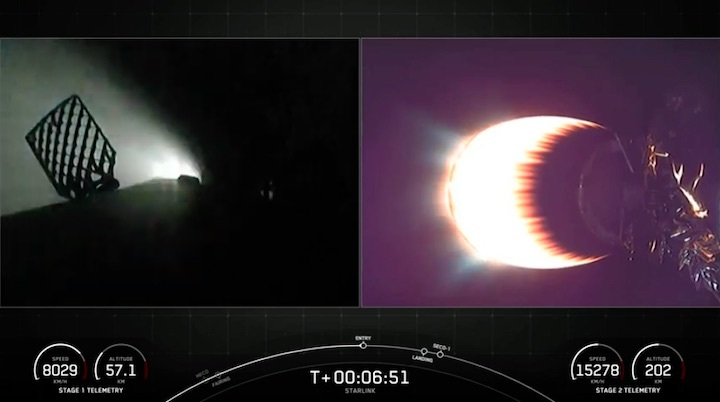
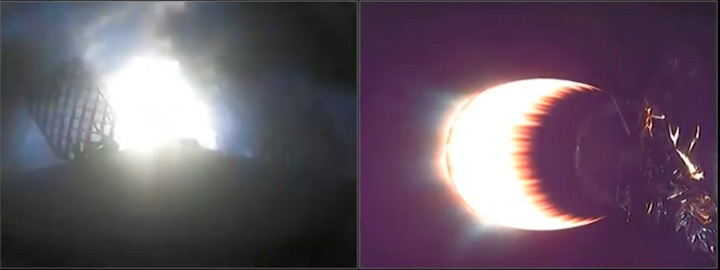
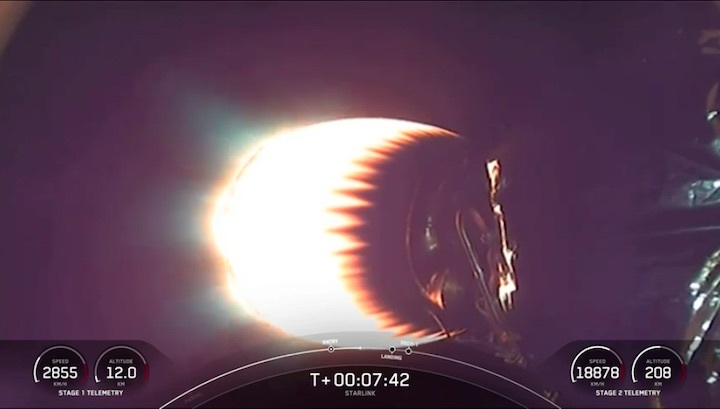
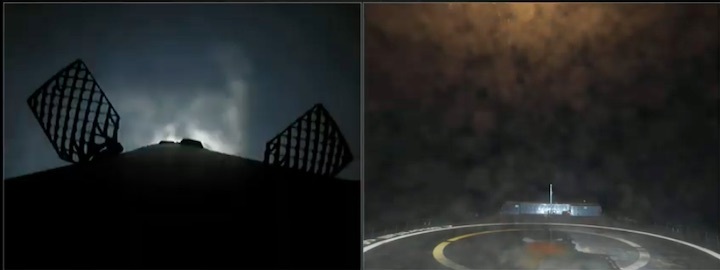
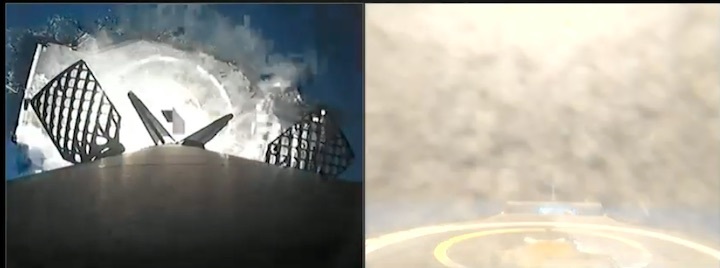
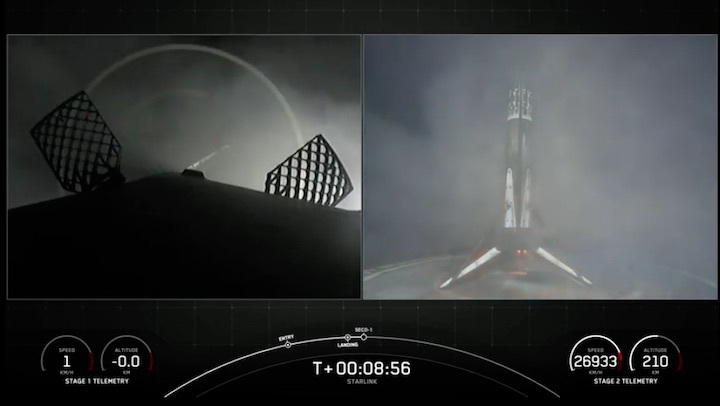
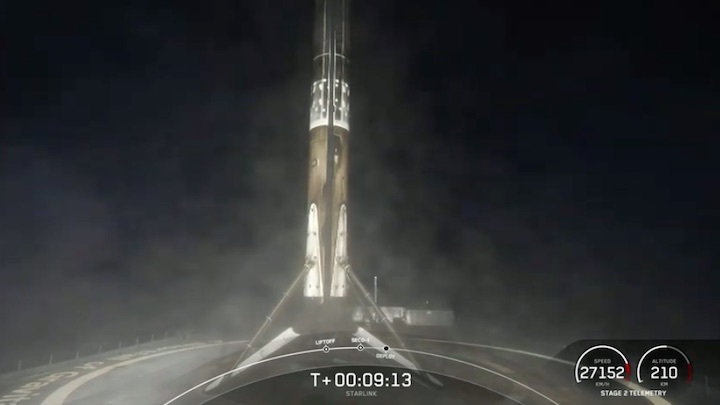
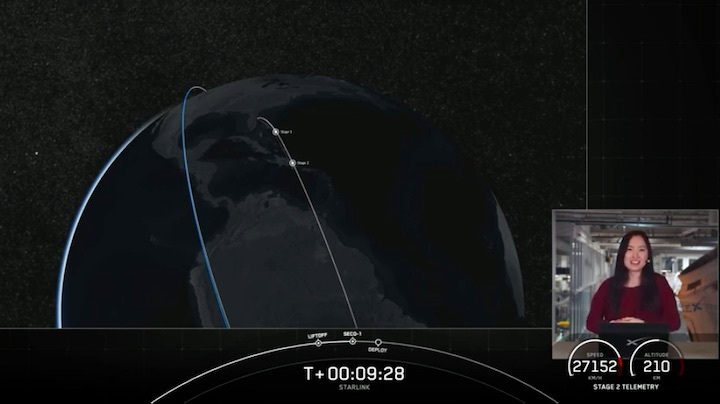
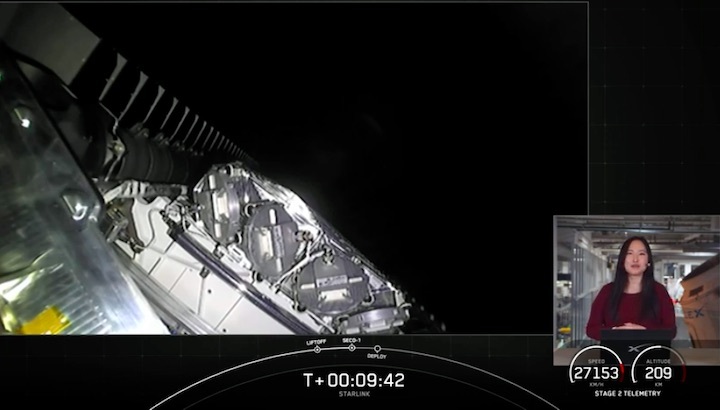
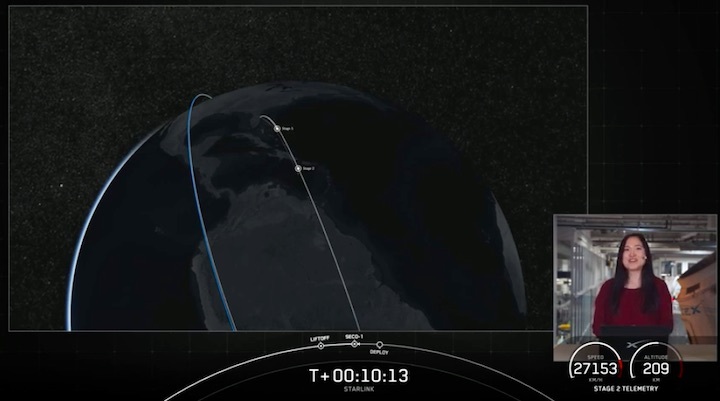
Quelle: SpaceX
+++
SpaceX passes 2,000 Starlink satellites launched
WASHINGTON — SpaceX passed the threshold of more than 2,000 Starlink satellites launched after a Falcon 9 placed another set of broadband internet spacecraft into orbit Jan. 18.
The Falcon 9 lifted off from Launch Complex 39A the Kennedy Space Center at 9:02 p.m. Eastern. The launch was originally scheduled for 7:04 p.m. Eastern, but SpaceX postponed the launch to the second of two opportunities that evening. The company did not disclose the reason for the delay.
The Falcon 9 second stage released its payload of 49 Starlink satellites into low Earth orbit 15 and a half minutes after liftoff. However, the deployment took place in a part of the orbit without ground station coverage, so confirmation did not come until the stage passed over a ground station in Alaska about an hour later.
The rocket’s first stage landed on a droneship in the Atlantic eight and a half minutes after liftoff. The stage made its 10th flight, after previously launching a GPS 3 satellite, the Turksat 5A communications satellite, the Transporter-2 rideshare mission, and six other Starlink missions. This is the fourth Falcon 9 booster to have completed at least 10 missions, including one that has launched and landed 11 times.
The 49 satellites on this mission, called Starlink 4-6 by SpaceX, bring the total number of Starlink satellites launched by the company to 2,042, according to statistics kept by astrophysicist and spaceflight analyst Jonathan McDowell. That figure includes two prototype “Tintin” satellites launched in February 2018 and the series of Starlink launches, carrying up to 60 satellites at a time, that started in May 2019.
Not all those 2,042 satellites are operational or even still in orbit. McDowell counts 1,879 satellites in orbit, counting this latest set of satellites, with 1,495 satellites in operational orbits. SpaceX Chief Executive Elon Musk, in a Jan. 15 tweet, said there were 1,469 satellites active, with 272 moving to operational orbits.
SpaceX’s current Starlink constellation is authorized for 4,408 satellites, all in orbits at around 550 kilometers. The company is seeking a Federal Communications Commission license for a second-generation system of approximately 30,000 satellites that it says would launch using its Starship vehicle under development.
The growth of satellite megaconstellations in general, and Starlink in particular, has worried astronomers, who fear that the satellites will interfere with observations of the night sky. Those concerns prompted a series of workshops as well as discussions with SpaceX, which has taken steps to reduce the brightness of its satellites.
In a paper published Jan. 17 in The Astrophysical Journal Letters, astronomers assess the effect that Starlink had on one observatory, the Zwicky Transient Facility (ZTF) at Palomar Observatory in California. The research found a sharp increase in the number of images taken near dawn and dusk that had streaks from satellites.
“In 2019, 0.5% of twilight images were affected, and now almost 20 percent are affected,” said Przemek Mróz, lead author of the study, in a Caltech news release about the research.
However, the same study found little evidence that the satellite streaks were interfering with the science being done by the observatory, which tracks near Earth asteroids as well as phenomena like supernova explosions. “There is a small chance that we would miss an asteroid or another event hidden behind a satellite streak, but compared to the impact of weather, such as a cloudy sky, these are rather small effects for ZTF,” said Tom Prince, a Caltech professor emeritus of physics and a co-author of the study, in the release.
The study, though, found that SpaceX was falling short of a goal set by astronomers in reducing the brightness of the Starlink satellites. The ZTF measurements found that the Starlink satellites equipped with visors had an average magnitude of 6.8, slightly brighter than the threshold of magnitude 7 set by astronomers to minimize effects on sensitive instruments, like the camera that will be used with the Vera Rubin Observatory under development in Chile.
Quelle: SN

